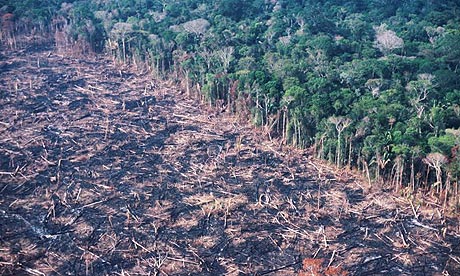A purring monkey, a vegetarian piranha and a flame-patterned lizard are among more than 400 new species of animals and plants that have been discovered in the past four years in the Amazon rainforest, conservationists say.
Discovered through hundreds of scientific expeditions between 2010 to 2013, the total of 441 new species – all new to science – includes 258 plants, 84 fish, 58 amphibians, 22 reptiles, 18 birds and one mammal. This tally does not include discoveries of insects and other invertebrates.
"The more scientists look, the more they find," said Damian Fleming, head of programmes for Brazil and the Amazon at WWF-UK, which compiled the list. "With an average of two new species identified every week for the past four years, it's clear that the extraordinary Amazon remains one of the most important centres of global biodiversity."
Among the new species discovered is a "purring" Caqueta titi monkey (Callicebus caquetensis) of the Colombian Amazon, whose babies have an endearing trait: "All of the babies purr like cats," said scientist Thomas Defler, who helped discover the species. "When they feel very content they purr towards each other, and the ones we raised would purr to us."
A "warpainted lizard" (Gonatodes timidus) was discovered in the part of the Amazon that extends into Guyana. Despite its extraordinary colouring, this lizard is very shy and has a tendency to avoid being seen by humans.
Some species may be lost just as they have been discovered, scientists warned. The thumbnail-sized "thimble frog" has been given a Latin name (Allobates amissibilis) meaning "that may be lost", because it thrives in an area of Guyana that could soon be opened up to tourism.
Other species are under threat from development. The strictly herbivorous "vegetarian piranha" (Tometes camunani), inhabits rocky rapids in the Brazilian Amason where its main source of food, Podostemaceae aquatic herbs, is found. However, dam projects and mining activity in Pará state are threatening the health and flow of its river habitat.
Many of the recently discovered plants and animals have very restricted ranges and are thought to be endemic to small parts of the Amazon. For example, a new fish species (Apistogramma cinilabra) that has adapted to low-oxygen water is unique to one small lake in the Loreto region of Peru and found nowhere else in the world – making it and other species even more vulnerable.
"The richness of the Amazon's forests and freshwater habitats continues to amaze the world," added Fleming. "But these same habitats are also under growing threat. The discovery of these new species reaffirms the importance of stepping-up commitments to conserve and sustainably manage the unique biodiversity and also the goods and services provided by the rainforests to the people and businesses of the region."
The Amazon ecosystem is the world's largest tropical rainforest and river system, covering 6.7m square miles shared by Brazil, Bolivia, Peru, Ecuador, Colombia, Venezuela, Guyana, Suriname and French Guiana. It is rich in biodiversity, containing one in 10 of the species known on Earth in 1.4bn acres of dense forest and 4,100 miles of winding rivers.
A recent study found that almost 400 billion trees belonging to 16,000 different species grow in the Amazon.
Deforestation, intensive farming, climate change, natural resources extraction and hydropower are among the chief threats to the forest and freshwater ecosystems.
About one-fifth of the Amazon rainforest has already been lost, and deforestation is currently taking place at a rate of three football pitches of a minute, WWF says. In the past eight years, Brazil has slowed the pace of forest clearance by 80%, but roughly 6,000 sq km is still converted to farmland each year.
The Amazon contains 90-140bn metric tonnes of carbon, the release of which through deforestation and land conversion – if not controlled – could accelerate global warming significantly.











